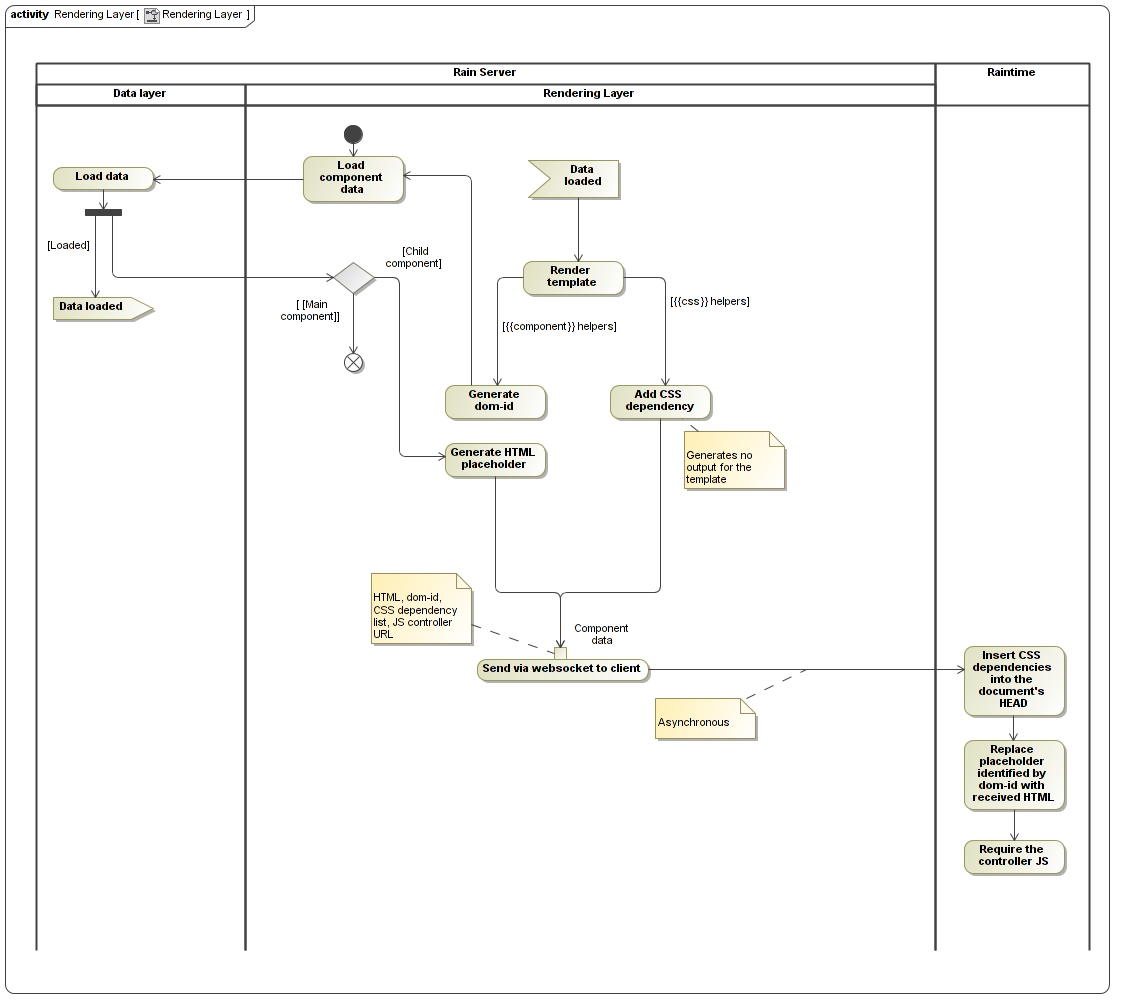Rendering Process¶
The whole rendering process consists of 3 layers. All of them are easy expendable with plugins.
- Template Compiler
- Data Layer
- Renderer
Template Compiler¶
- All the templates will be compiled when the server is starting.
Data Layer¶
- Receives the data from the renderer and invokes the getTemplateData( params ) function in the server-side-controller. The data contains the dataid of the component and the parameter for the function request.
- The server-side-controller function getTemplateData( params ) returns the data back to the renderer Layer. The data must be a valid JSON Object!
- When the data layer receives the JSON Object from the server-side-controller the data layer sends the data to the renderer.
Code¶
1 2 3 4 5 6 7 8 9 10 11 12 13 14 15 16 17 18 19 | /**
* @param {Object} componentOptions
* @param {Function} callback function which receives the error and data as parameter
*/
LayerData.prototype.loadData = function(componentOptions, callback) {
var templateData = null,
err = null;
/**
* LOAD DATA
*
* 1. get server-side-controller of component template from componentContainer
* 2. invoke getTemplateData() with params if necessary
* 3. invoke getTranslationData()
* 4. fill templateData and error if there is an error
* 5. invoke callback with these parameters
*/
callback(err, templateData);
};
|
1 2 3 4 5 6 7 8 9 10 11 12 13 14 15 | ServerSideController.getTemplateData(parentData) {
/**
* Do some service requests
*/
var templateData = JSON.parse(dataFromService);
return templateData;
}
ServerSideController.getTranslationData() {
/**
* Do some service requests
*/
var translationData = JSON.parse(dataFromService);
return translationData;
}
|
Rendering Layer¶
The rendering layer takes care of rendering a pre-compiled template with a data context. The data context is made available by the component’s server-side controller or by arguments passed from the parent template.
A handlebars helper with the following syntax is used for aggregating components:
{{component id opt-param-1 opt-param-2 opt-param-3="value" opt-param-4="value"}}
As specified in Handlebars’ documentation, a helper can receive parameters such as opt-param-1 and opt-param-2 and/or key-value pairs. Parameters and key values are treated as Handlebars Expressions. Please read Handlebars’ documentation for more information.
The helper is registered in Handlebars as such:
1 2 3 4 5 6 7 8 9 10 11 | Handlebars.registerHelper('component', function (id) {
// 'id' is the component's identifier
// Optional parameters are from the second to the penultimate argument
var params = Array.prototype.slice.call(arguments, 1, -1);
// Key-value pairs are stored in the last argument's 'hash' property
var options = arguments[arguments.length - 1].hash;
// ...
}
|
The steps the rendering process goes through when rendering a component (including the top-level one) are the following:
Asynchronous loading of the component’s data is triggered
The data response arrives [1]
Template begins rendering
3.1. {{css}} helpers generate css dependencies and provide no output
3.2. {{component}} helpers are rendered
3.2.1. Generate dom-id for the current aggregation context
3.2.2. Go to step 1 for this component
3.2.3. Return HTML placeholder with generated dom-id for parent component [2]
Send rendered component to the client via websocket along with the list of CSS dependencies, the client-side JS controller and its dom-id [3]
Insert the component into the document
5.1. Insert CSS dependencies into the HEAD of the document
5.2. Require the JS controller to be loaded (via requireJS)
- 5.3. Insert the received HTML rendered content into the correct
placeholder according to the received dom-id

Footnotes
| [1] | In the meantime, the server is free to process other things |
| [2] | Since step 1 of the process starts an asynchronous call, step 3.2.3. is immediately reachable and the {{component}} renderer can quickly return a placeholder to the parent component |
| [3] | The dom-id for the top-level component has a special value that triggers that component’s rendered content to be inserted into the document’s BODY rather than into a specific placeholder |